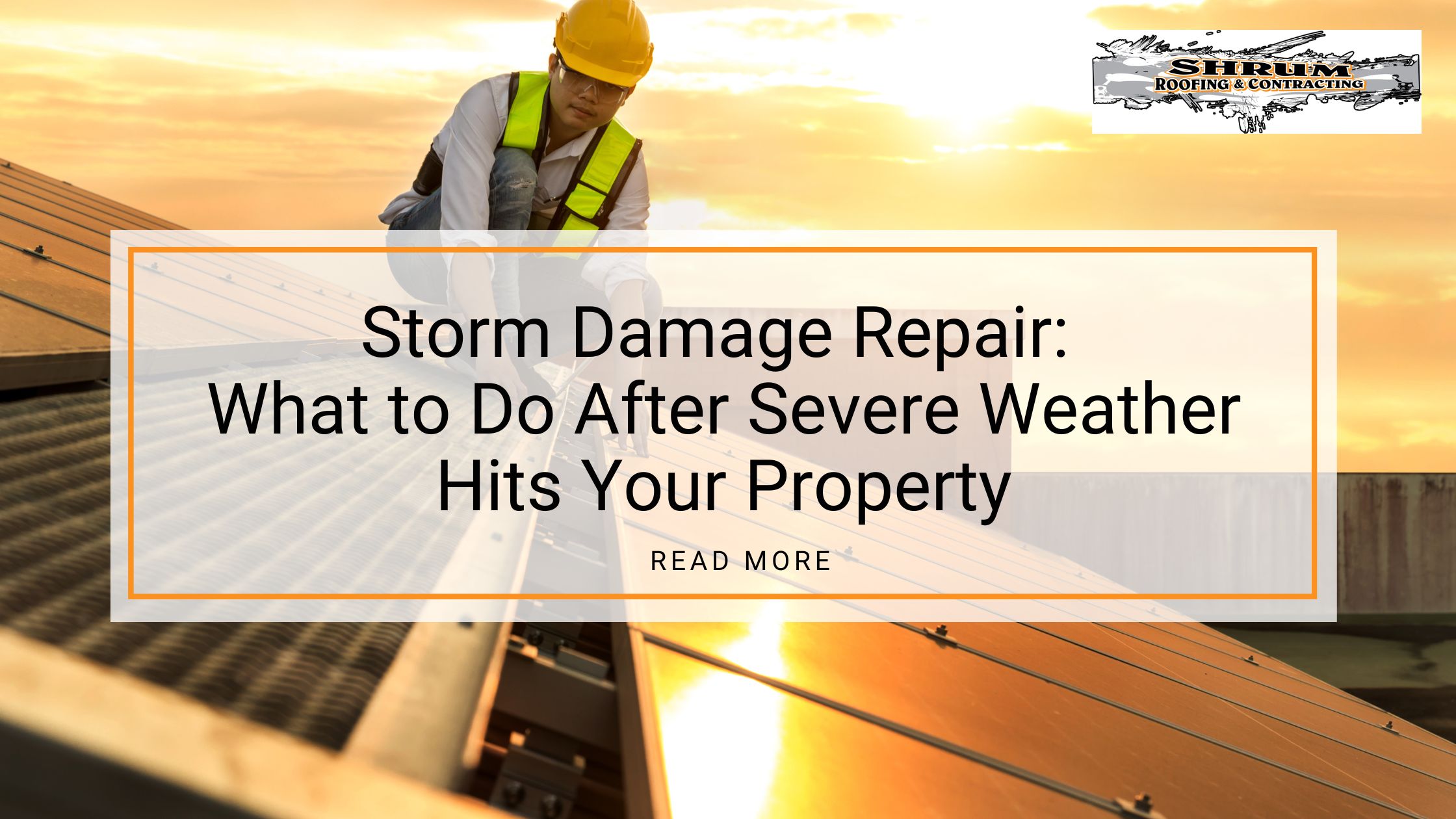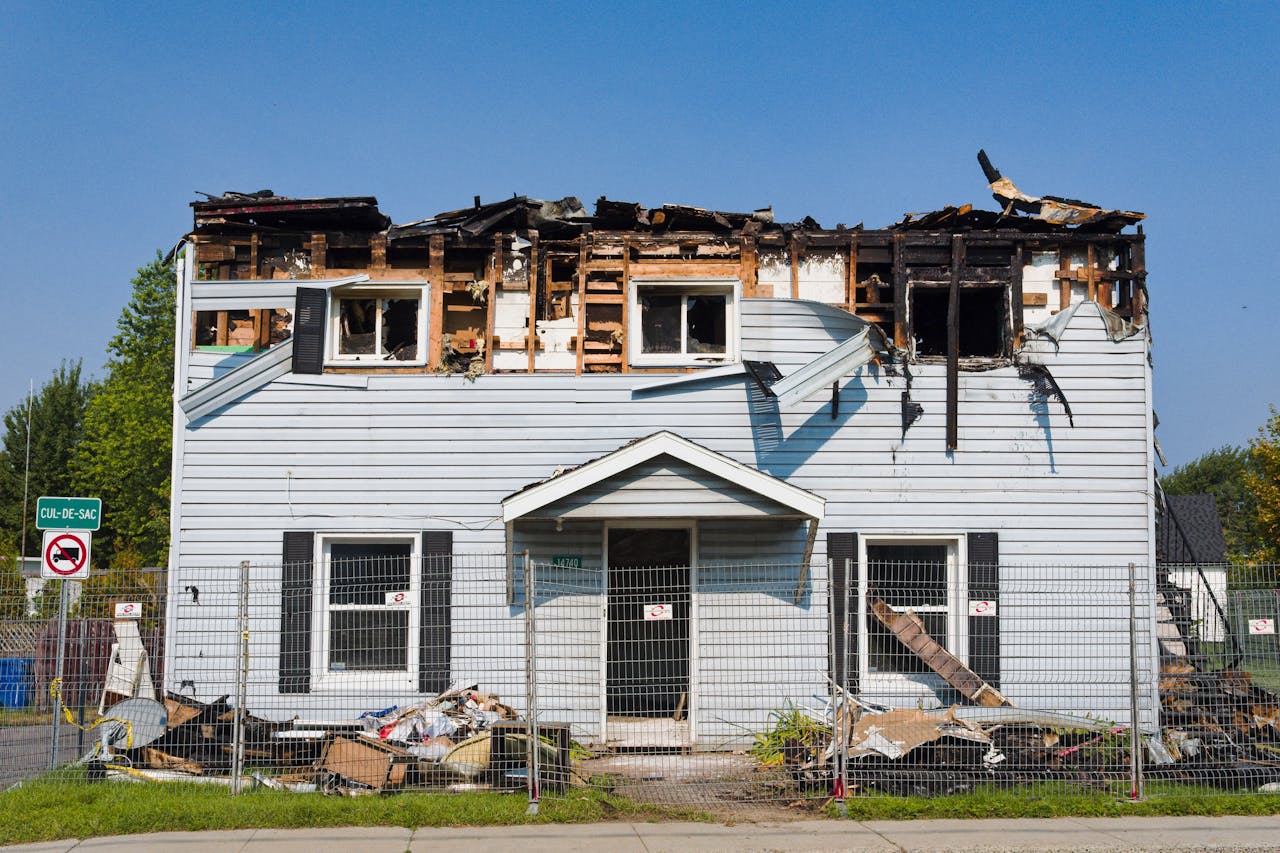Storm Damage Repair: What to Do After Severe Weather Hits Your Property

- After a storm, it’s crucial to inspect your property for visible and hidden damage, document everything for insurance purposes, and take immediate steps to prevent further deterioration.
- Addressing storm-related issues quickly, including roof repairs, water damage mitigation, and structural fixes, helps maintain your home’s integrity and avoids costly long-term problems.
- Shrum Roofing & Construction provides expert storm damage repair, offering thorough inspections, high-quality repairs, and professional guidance to restore and protect your home efficiently.
Severe weather can leave a trail of destruction, from minor roof leaks to significant structural damage. The aftermath can be overwhelming, but taking the right steps early can prevent further complications and ensure a smooth restoration process. Whether it’s a thunderstorm, hailstorm, or hurricane, knowing how to assess the damage, work with your insurance company, and find a reliable contractor will help you restore your property efficiently. Acting promptly not only protects your home but also minimizes long-term repair costs.
Understanding what to do after a storm hits is crucial for homeowners. This guide will walk you through the essential steps to take after severe weather impacts your home, helping you navigate the recovery process with confidence.
Prioritize Safety First
After a storm, ensuring safety should be your first concern. Strong winds, heavy rain, and hail can create hazardous conditions. Stay away from fallen power lines and report them immediately to utility providers. If structural instability is suspected, do not enter the building until a professional deems it safe.
Broken glass, nails, and sharp debris can pose injury risks, so wear protective gear when inspecting the damage. If you detect a gas leak, evacuate the area immediately and contact emergency services. If the damage appears severe, it’s best to wait for professional assistance before re-entering the property.
Conduct a Thorough Inspection
Once it is safe, assess your property carefully. Walk around the exterior to check for missing or damaged shingles, dents or cracks in siding and gutters, and any broken windows or damaged doors. If trees or heavy debris have landed on the roof, avoid attempting to remove them yourself.
Inside, look for water leaks, stains on ceilings and walls, sagging ceilings, warped floors, or a musty smell—these could indicate hidden water damage. A flashlight can help when checking dark areas such as attics and basements. Even if the damage seems minimal, a professional inspection can uncover issues that might worsen over time.
Document the Damage
Taking detailed photos and videos of storm damage will help when filing insurance claims and working with contractors. Capture multiple angles of your roof, siding, gutters, windows, and interior damage such as leaks or collapsed ceilings. Keep a written record of damages and any temporary measures you take, like covering holes with tarps or boarding up windows.
Additionally, maintain copies of all communication with insurance companies and contractors. Proper documentation ensures that all damage is accounted for and can help speed up the claims process.
Contact Your Insurance Provider
Notify your insurance company about the damage as soon as possible. Be prepared to provide the documentation you gathered and discuss the details of the storm and your property’s condition. An insurance professional will likely visit to assess the damage and determine coverage.
Reviewing your policy beforehand can help you understand coverage limits and deductibles. Keep receipts for any temporary repairs or accommodations if needed. Follow up regularly to track the status of your claim and avoid signing repair contracts until your claim is approved.
Prevent Further Damage
Insurance companies often require homeowners to take reasonable steps to prevent additional damage. Cover exposed areas with tarps to prevent water infiltration, seal broken windows or doors with plywood, and remove loose debris that could cause further harm.
If leaks are present, place buckets or containers underneath to minimize interior water damage. While these temporary fixes help protect your home, avoid making permanent repairs until insurance assessments are complete, as this may affect claim eligibility.
Roof Inspections and Repairs
Your roof takes the brunt of the elements when storms roll through. High winds can rip off shingles, hail can leave dents and punctures, and heavy rain can expose weak spots, leading to leaks. Even damage that seems minor can worsen over time, causing costly structural issues if left unchecked.
A thorough inspection by a professional roofing contractor involves:
- Shingle Evaluation: Checking for cracks, curling, missing sections, or granule loss, which can compromise protection.
- Structural Assessment: Identifying soft spots, weakened decking, or sagging areas that may indicate deeper damage.
- Flashing and Sealant Check: Examining flashing around chimneys, vents, and skylights to ensure a tight seal against moisture intrusion.
- Leak Detection and Repair: Finding and fixing leaks before they lead to mold growth, wood rot, or insulation damage.
Routine maintenance and post-storm inspections are essential for catching small problems before they escalate. By addressing issues promptly, you can extend your roof’s lifespan and avoid expensive repairs down the road.
Address Structural and Exterior Damage
Storms can impact more than just the roof. Strong winds and debris can cause significant exterior damage. Siding may have cracks, holes, or missing panels that can lead to water damage and reduced insulation. Gutters and downspouts should be checked to ensure they are securely attached and directing water away from the foundation.
Windows and doors with broken glass or misaligned frames should be repaired promptly to maintain security and energy efficiency. Fences, garages, and sheds should also be examined for structural weaknesses. Prompt repairs not only restore the appearance of your home but also prevent further deterioration.

Water Damage Mitigation
If water has entered your home, quick action is essential to prevent mold and structural issues. Use fans, dehumidifiers, and ventilation to dry out wet areas. Remove soaked carpets, furniture, or drywall if necessary. Mold growth can begin within 24 to 48 hours, so checking for early signs is crucial.
If water damage is extensive, hiring professional remediation services is the best way to ensure complete drying and decontamination. Addressing water damage early will protect your home from long-term complications and costly repairs.
Check for Hidden Damage
Not all storm damage is immediately visible. Small roof punctures, weakened support beams, or foundation shifts may go unnoticed but create problems over time. Water can seep into walls, leading to structural decay and mold growth.
Schedule a professional inspection to identify any concealed issues before they lead to more significant repairs. Even if your home appears intact, underlying damage can compromise its integrity if left unchecked.
Plan for Future Storm Protection
Once your home is repaired, consider improvements to enhance storm resilience. Upgrading to impact-resistant roofing materials can help withstand high winds and hail. Reinforced windows and storm shutters provide better protection during extreme weather. Strengthening drainage systems around your home can prevent flooding and foundation damage.
Regular maintenance and inspections will help identify vulnerabilities before storms hit, reducing future repair costs. Taking proactive measures now can save you from dealing with extensive damage later.
Work with a Reputable Storm Damage Repair Specialist
Choosing the right contractor is crucial for quality repairs. Beware of storm-chasing contractors offering quick fixes at inflated prices. A reputable contractor should be licensed, insured, and have a solid local reputation.
Look for specialists in storm damage repair who provide detailed written estimates and work with insurance providers to streamline the claims process. They should also use high-quality materials, follow local building codes, and offer warranties on their work to ensure long-term protection for your home. Checking customer reviews and asking for references can also help you find a trustworthy professional.
Understand the Timeline for Repairs
Storm damage restoration doesn’t happen overnight. Some repairs, such as temporary fixes to prevent further damage, can be completed quickly, while structural repairs may take longer. The timeline depends on factors such as insurance claim approvals, availability of materials, and weather conditions.
Large-scale repairs often require permits, which can add to the timeframe. Setting realistic expectations and working with an experienced contractor can help ensure a smooth and efficient process.
Keep Up with Regular Home Maintenance
Preventive maintenance is key to minimizing storm damage in the future. Routine roof inspections, clearing gutters, trimming trees, and securing outdoor furniture can help protect your property. Reinforcing doors and windows and checking your foundation for cracks can further safeguard your home.
Ensure your drainage systems direct water away from your home to prevent flooding. Inspect siding for weaknesses, replace damaged shingles, and seal any openings where water or pests could enter. Addressing minor repairs before they become major issues can save you time and money when the next storm hits.
Know When to Replace Instead of Repair
In some cases, storm damage may be so severe that repairs alone won’t be sufficient. If your roof has sustained repeated damage over time, replacing it with a more durable material could be a better investment. The same applies to old windows, siding, or structures that have weakened beyond repair. Consulting with a professional contractor will help determine whether repairs will suffice or if a full replacement is the best option for long-term protection.
When severe weather strikes, you need a team you can trust. At Shrum Roofing & Construction, we provide expert storm damage repair, ensuring your home is restored quickly and efficiently. Contact us for a professional inspection and high-quality repairs to protect your property for years to come.
